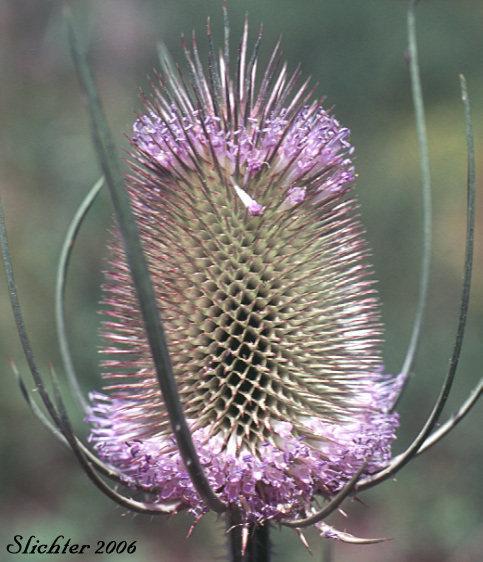 -
- 
Teasel is a biennial herb with thick, erect stems from 0.5-2 meters hight. The stems are angled and marked with fine, parallel lines or grooves and become increasingly prickly upwards. The leaves are also more or less prickly, especially along the lower midrib. The rest of the blades are largley glabrous. The basal leaves are oblanceolate in outline and typically whither and dry up early during their second year. The stem leaves are lanceolate in shape, tapering to a pointed tip with prickly margins (See photo.) and may attain lengths as great as 30 cm. The stems may be branched on the upper stem, with the branches arising at the axils of the opposite leaves.
The erect flower heads are ovoid or long and cylindric, measuring from 3-10 cm long. They are found at the tip of the stem and consist of numerous tightly congested flowers. The long, thin involucral bracts are noticeably prickly along the lower half and sharp at their tip, and typically extend upwards past the flower heads (See photo above.). The slender corollas are tubular, 10-15 mm long with 4 short lobes up to 1 mm long. The tube is generally whitish while the corolla lobes are purplish.
Teasel is a bothersome weed which self-seeds and spreads easily. It can be controlled without herbicides by cutting the stems near the ground when they are several feet high, and preferably before they flower. This is done in late spring or early summer of their second year. Evidently the roots are unable to generate sufficient regrowth to produce new flower heads and the plants then die at the end of the growing season. Because of the prolific seeding however, one will need to revisit established sites over a period of years and repeat this process to successfully eradicate them from the site.
A European weed, teasel is commonly found iiin moist meadows and moist-disturbed areas below 2000 meters in elevation.
A native species of Europe, teasel has been introduced to much of North America.
In the Columbia River Gorge, it may be found between the elevations of 0-400' from near the mouth of the Sandy River in the west and eastward, extending at least as far east as The Dalles.